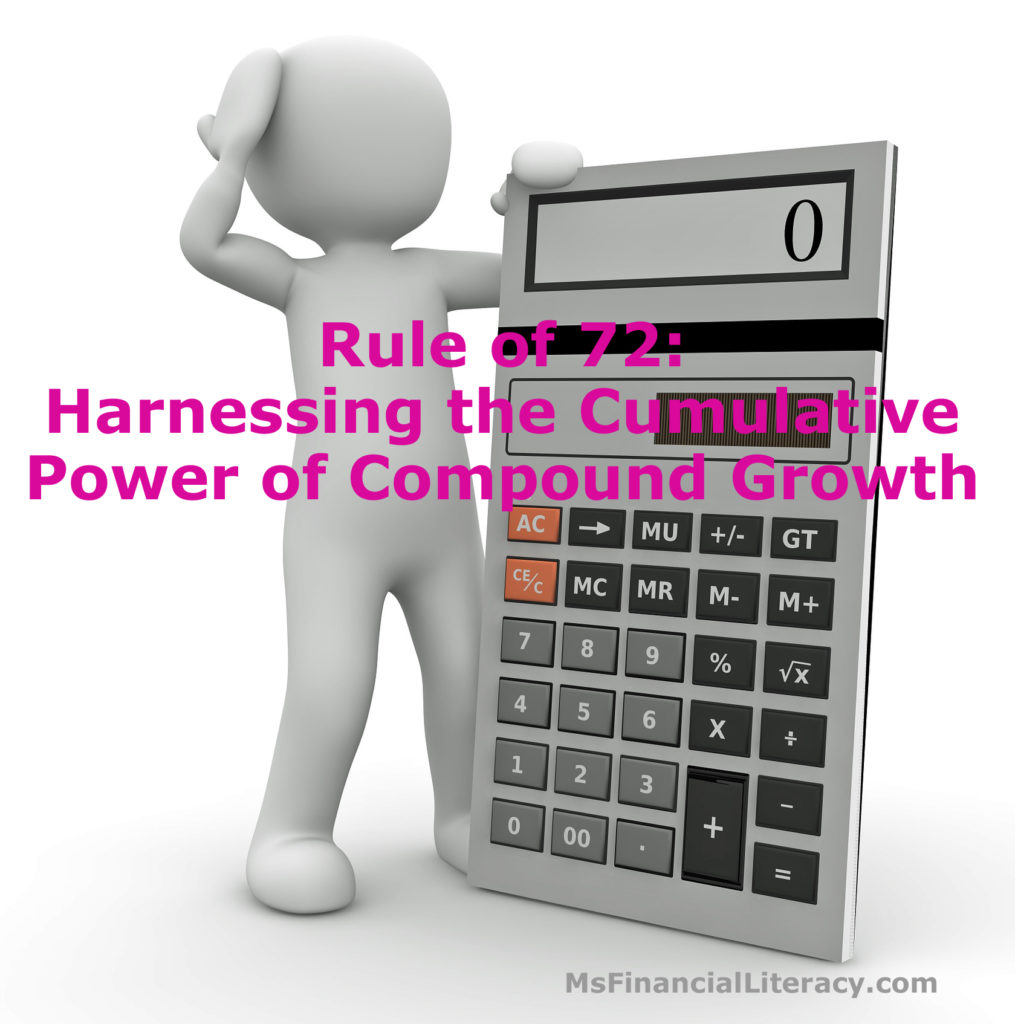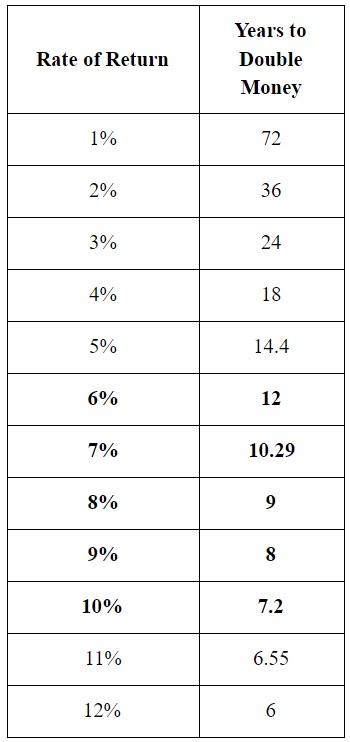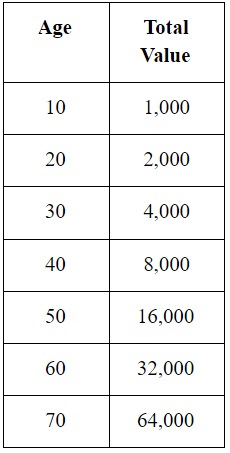Readers, does hearing about the prospect of doubling your money get you excited? Wondering what’s the best way to start saving for retirement? Would you be more likely to do financial planning if you have access to simple and efficient tools? Do compound interest formulas intimidate you? Don’t know how to use a financial calculator or don’t carry one in your purse? If you responded “yes” to any of the questions above, the Rule of 72 can be your friend.

Mathematical formulas don’t excite me. I skip over them in my readings. While I enjoy thinking about retirement, I am not interested in running the numbers. Even retirement calculators ask for numbers! My husband told me about the concept of compounding shortly after we met, but I had a hard time grasping how the numbers could work in my favor. Or was that a form of mental resistance?
Over the years, I’ve learned several shortcuts and numbers to help me with financial planning. The Rule of 72 is certainly one of the simplest and most powerful. It literally changed the way I think about money, my perception of time, my spending habits, my savings rate and my relationship with my husband. So, let’s take a closer look at what the Rule of 72 can do for us. I certainly promised a lot (in my previous post as well)!
Scenario #1: Calculating the Number of Years Needed to Double One’s Money
My husband and I track our net worth. Every now and then I want to quickly estimate the time it would take to double our number. I know what the starting balance is (our total net worth). I have a pretty good idea what the stock market’s average rate of return is. That number is generally around 7. Without having to go out to buy a financial calculator, I use the Rule of 72.
Formula #1:
Estimated Number of Years to Double Money = 72 / i, where i is the Compound Annual Rate of Return
In my case, I take 72 and divide it by 7, which equals to 10.29. This is the number of years (about 10) it takes to double every dollar we have invested in our portfolio.
The table below shows the time horizon doubling your money at different rates of return. Easy, right? The calculation is reasonably accurate for growth rates that fall between six to ten percent.

If you follow the table, investments generating higher rates of return typically take less time to double. On the other hand, if you have money in a savings account that’s generates 1% interest rate, then it would take 72 years to double your account value (assuming no additional deposits)!
Scenario #2: Calculating the Rate of Return Needed
Early this year a friend approached my husband for advice with his retirement planning. This friend was looking to retire in 12 years and wanted to double his net worth by then. What rate of return must this friend earn to achieve his financial goal? Without needing to know more details about this friend’s financial situation, I can quickly use the Rule of 72 to come up with a rough estimate of the rate of return required to achieve such a goal.
Formula #2
Estimated Compound Annual Rate of Return = 72 / x, where x is the Number of Years You Wish to Double Money
In this case, I take 72 and divide it by 12, which equals to 6. The result, 6, represents 6%, is the estimated compound annual rate of return this friend will need to earn to successfully reach his goal.
Behind the Scene: Time, Rate of Return and Compound Growth
For those of us who don’t enjoy playing with complicated numbers and formulas, the Rule of 72 can be a quick and useful financial tool. More importantly, the examples helped us become more aware of the impact of time and rate of return on our savings, as well as the true power of compound growth. These concepts are the basis of the Rule of 72. They are the reason this rule is so powerful. Use this knowledge to your advantage as you make daily financial decisions. If the idea of seeing your money double excites you, think twice the next time you are pulling out your credit card to pay for a concert ticket or considering a loan to pay for a car.
From the perspective of compound growth, each dollar saved is important. And it’s easy to understand why when we look at the table below.

This table illustrates a hypothetical account of someone who started saving $1,000 at the age of 10. The account grows to $2,000 when this individual turns 20 (assuming an average growth rate of 7.2%), to $4,000 at age 30, to $8,000 at age 40, and so on. At first look, the time it takes to grow the total value from $1,000 to $2,000 might seem slow. The next step moving from $2,000 to $4,000 seems a little better. Then, we begin to see some bigger and even bigger jumps as we continue down the columns where $4,000 becomes $8,000, follows by $8,000 becoming $16,000 and so forth. This is the power of compounding over the long term. This is the value of time. Now that I am aware of these concepts, I no longer take time for granted. I no longer dismiss the small value of a dollar. During my lifetime, this $1 is going to exponentially multiply.
Caveats and Limitations
The math behind how the number, 72, is derived, involves several formulas on future value of investments and compound interest. If you follow the calculations, the actual number is 69 [this would have been a great number to work with]. Thanks to a bunch of financial experts/economists who wanted to make life easier for us, they rounded the number to 72. This number happens to be divisible by 1, 2, 3, 4, 6, 8, 9, 12, 24 and 36!
The Rule of 72 comes with limitations. As I wrote in an earlier article, rules of thumb should only be used as guidelines and references. They are shortcuts and only provide approximations. If you are serious about doing financial planning, you either need to do extensive research on your own or hire a professional. I have been lucky my husband is very good working with complicated numbers and formulas.
With all that aside, what are some considerations we need to be aware of? First, the stock market rarely generates a constant rate of return, unless you invest your money in long-term fixed incomes (e.g., a 20-years maturity long-term bond). Second, the Rule of 72 calculations don’t adjust for tax or inflation. Third, you might be tempted to put your savings in something that potentially generates 15 or 20% rate of return. This way, your money would double within 5 years. Be very cautious. Consider your time horizon to retirement and risk tolerance. In general, assets that promise high percent of rate of return also tend to carry higher premiums of risks and less creditworthiness (such as junk bonds). People who invested with Bernie Madoff aren’t happy now. They got promised high returns.
Concluding Remarks
My fear of numbers certainly held me back from working toward similar financial goals along with my husband. Not having a full understanding of the cumulative power of compound growth has been costly. I used to love designer handbags. Each time I pulled out my credit card, I only thought about the many years ahead I’ll be enjoying that bag. If I was going to buy the bag sometime during my life anyway, I might as well buy it now (you can read more about my spending habits in this post).
That was before I knew about the power of compound growth over the long term. Once I internalized the concepts behind the Rule of 72, my attitudes and behaviors toward savings became more aligned with those of my husband’s. I prioritized the things that truly make me happy and started doing more and more of those (such as reading personal finance books, listening to podcasts and building this website). Once I started doing all these in addition to working full time and taking care of my family, I rarely have time to shop!
What has the Rule of 72 taught us? For one, use compound growth to your advantage. Time is one of the most important factors to grow your savings. Start saving for retirement as early as possible. If you have 30 years before retirement, your savings today have the potential to grow eight fold. If you have 20 years, your savings have the potential to grow four fold. The Rule of 72 makes it clear how much more you can save by starting earlier. Your nest egg has the potential to grow bigger and bigger over the long term.
Second, take the time to do research and see how various investment strategies meet your financial goals. Whether you’re investing in the stock market, buying rental properties or putting money in a savings CD, consider your rate of return. Always take into account your time horizon for meeting those goals and your risk tolerance level. Chasing the highest rate of return is risky. At the same time, you don’t want to be so conservative that you are putting everything dollar into a savings account that yields a 1% interest rate or investing in a bond funds that yield 2%. In future posts, I will talk more about asset allocation strategies.
Your turn!
Readers, were you familiar with the Rule of 72?
If so, how did you hear about it? Is there anything else you would like to add?
For those of you reading about the rule for the first time, do you feel encouraged to start saving or increase your savings rate as high as you can?
Will you be using the Rule of 72 to help you track the progress of your financial goals?
Are you excited now that you know how your savings can grow?
